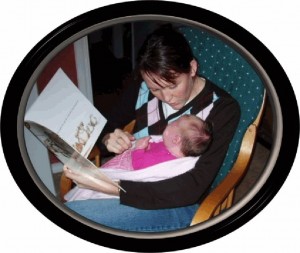Last week I put on my casual relief/substitute’s hat and over three days I taught ten classes – over 250 children aged between four and nine. And each of those children heard at least one story read aloud to them as part of a series of lessons I’d prepared in consultation with the regular TL and their classroom teachers.
But was I exploiting my position and offering “a fallback lesson” because I hadn’t planned “something more engaging and creative” , doing something that “a clerk…a parent or even a higher level student could do” as I sat “in front of a bunch of students holding a book — usually with a lot of pictures –” while I contorted myself “to occasionally show the kids a picture — which cannot possibly be seen by the kids in the back row”? Even though I “know how to read” (so presumably the activity was not adding to my professional learning), were the children merely sitting there “engaged(?) in a basically passive activity”?
This was an observation posed on an international teacher librarian message board this week – posed not by a parent or a principal, but by an instructor in library science in a US university whose job it is to observe and mentor those who wish to join our profession as they undertake their practica as part of their learning journey. The inquirer admitted that his entire career had been spent in the secondary sector but it is very disturbing that one whose job is to guide those who will follow in our footsteps had not bothered to acquaint himself with the very fundamentals of what it is to be a teacher librarian in a primary/elementary school where supporting the development of reading skills is as critical as supporting the development of research skills. Because if a child cannot read, how can they conduct effective and efficient research?
As many respondents indicated, the read-aloud hat is one of the most important in our wardrobe.
If reading to children were common instead of a rarity, we’d be facing fewer academic and social problems in this nation.
Trelease, J. 2001 The Read-Aloud Handbook 5th ed., New York: Penguin
In Reading Magic, which international literacy consultant and children’s author Mem Fox believes may be “the most important contribution I have made to the world” the benefits of reading aloud to a child from the day it is born are explicit. Reading aloud to a child in the first four months of its life is critical for laying down the foundations for successful reading later.
This book is a must-read for every teacher librarian and a must-have in every collection for teachers AND parents to borrow. In Chapter 2, The Magic in Action, Fox describes a 15-minute session she spent with three-year-old Ben during which they shared three books and the joy and delight both experienced as they did. Apart from anything else, it was all about two people having a great time together.
Engaging in this kind of conspiracy with children is perhaps the greatest benefit of reading aloud to them… The fire of literacy is created by the emotional sparks that fly when a child, a book and the person reading make contact.
Sadly, many parents don’t, won’t or can’t read to their child during those critical early years and so it becomes the teacher’s and the TL’s job to do so. Through reading aloud, the child learns
- the sounds and nuances of the language it is likely to speak most fluently throughout their life. By 12 months the connections in the brain have been made and no matter what, no other language will ever become as natural as the one heard during that time. Children cannot learn to talk without being spoken to and sharing a story and having a conversation about it brings a new dimension to the everyday topics introducing new ideas and understandings as well as introducing new words and ways to express them, building their confidence to speak in front of others
- the abilty to concentrate for an extended period of time so the full story can be enjoyed, even savoured; the ability to solve problems and begin to predict, understand cause and effect; and the ability to participate in tricky situations and life lessons at arm’s length using their existing knowledge while being able to take risks in a very safe environment
- the language of books through phrases such as ‘once upon a time’ and ‘happily ever after’; through the formal grammar of the writng; through the rhyme and rhythm and repetition of the words; through the expression used as characters are assumed and they hear what their own inner voice should sound like in different situations
- concepts about stories allowing them to go beyond their everyday lives, flying on imaginary journeys, meeting amazing people and taking part in spectacular events; concepts about stories being complete entities contained in a physical vessel; concepts about print and pictures, their purpose and how they work
- about the cultures, ideologies, socioeconomic circumstances, and timeframes, that the stories they hear span and this enables them to bridge the gap between what is and what is imagined
- to imagine, and as Einstien (Saturday Evening Post, 1929) proclaims “imagination is more important than knowledge”. Without imagination we cannot predict, pretend, or propose – critical elements of problem solving
- how characters are developed and the issues and dangers of stereotyping; how mood and atmosphere can add to the interpretation;
- the foundations of the information literacy process as they hear questions modelled, learn to read the pictures, participate in discussions, consider perspectives and justify their point of view
- that reading opens up a world of topics, genres, authors and series that they might never discover for themselves
But most importantly, they learn that reading is fun; it is valued by the adults in their lives so it is a worthwhile skill to have and activity to participate in; and it is something they can succeed at and enjoy. Rather than just showing them the path that leads to a world of wonder, reading aloud to them helps take them along it. If you or your colleagues and community are still not convinced then read the research… Reading to Young Children: A Head-Start in Life by a partnership arrangement between the Department of Education and Early Childhood Development and the Melbourne Institute of Applied Economic and Social Research or The Read-Aloud Handbook by Jim Trelease. (He even offers free, downloadable brochures to display or distribute.)
However, reading aloud isn’t enough if it doesn’t engage the listener. While Mem Fox focuses on the parent-child relationship and the privilege of sharing stories at bedtime to close the curtains on the day, the TL is more often in a 1:many situation in less-than-ideal circumstances. To help address this I’ve written The Art of Reading Aloud. It focuses on
- creating a special space
- choosing the story
- setting the scene
- the art of reading aloud
This last section is critical because it is the performance part – the part that will leave the lasting impression and leave the child wanting to be entertained that way again whether they are sharing a one-stop picture book or a serial spread over several reading times. It encourages you to watch children’s programs which share stories and model how the listeners are engaged and then practice, practice, practice. If I can have a group of 9 year-old boys entranced in The True Story of the Three Little Pigs by Jon Scieszka or 12 year-olds absorbed in The Pain and the Great One by Judy Blume (both picture books written for a younger audience) then anything’s possible.
Reading aloud does not stop just because students are old enough to read for themselves and so it’s abandoned. But there are many reasons why we should continue to read aloud well beyond that.
This blog post explains why this teacher is reading 180 picture books to her Yr 7s and 8s over the school year and the impact it is already having after just three weeks, and The Reading Promise is the story of the bond formed between a father and daughter through reading aloud.
Whether you are reading aloud to your child or to a class, do it as well as you can – you are conveying much more than the words on the page.
The read-aloud hat is so important we must wear it well and wear it with pride.

